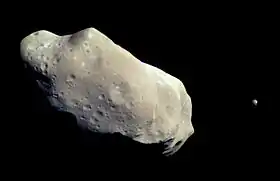Kari (moon)
Kari or Saturn XLV is a natural satellite of Saturn. Its discovery was announced by Scott S. Sheppard, David C. Jewitt, Jan Kleyna, and Brian G. Marsden on 26 June 2006 from observations taken between January and April 2006.
 Kari imaged by the Cassini spacecraft in May 2017 | |
| Discovery | |
|---|---|
| Discovery date | 2006 |
| Designations | |
Designation | Saturn XLV |
| Pronunciation | Icelandic: [ˈkʰaːuri] |
Named after | Kári |
| S/2006 S 2 | |
| Orbital characteristics [1] | |
| 22118000 km | |
| Eccentricity | 0.478 |
| −1233.6 days | |
| Inclination | 156.3° |
| Satellite of | Saturn |
| Group | Norse group |
| Physical characteristics | |
Mean diameter | 6+50% −30% km[2] |
| 7.70±0.14 h[2] | |
| 23.9 | |
Kari is about 7 kilometres in diameter, and orbits Saturn at an average distance of 22,305,100 km in 1243.71 days, at an inclination of 148.4° to the ecliptic (151.5° to Saturn's equator), in a retrograde direction and with an eccentricity of 0.3405. The rotation period has been determined to be 7.7±0.14 hours.[2]
It was named in April 2007 after Kári, son of Fornjót, the personification of wind in Norse mythology.
References
- S.S. Sheppard (2019), Moons of Saturn, Carnegie Science, on line
- Denk, T.; Mottola, S. (2019). Cassini Observations of Saturn's Irregular Moons (PDF). 50th Lunar and Planetary Science Conference. Lunar and Planetary Institute.
- Institute for Astronomy Saturn Satellite Data
- IAUC 8727: Satellites of Saturn June 30, 2006 (discovery)
- MPEC 2006-M45: Eight New Satellites of Saturn June 26, 2006 (discovery and ephemeris)
- IAUC 8826: Satellites of Jupiter and Saturn April 5, 2007 (naming the moon)
- Denk, T., Mottola, S. (2013): Irregular Saturnian Moon Lightcurves from Cassini-ISS Observations: Update. Abstract 406.08, DPS conference 2013, Denver (Colorado), October 10, 2013 (synodic rotation period)
This article is issued from Wikipedia. The text is licensed under Creative Commons - Attribution - Sharealike. Additional terms may apply for the media files.
.jpg.webp)


